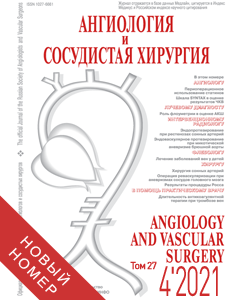Journal «Angiology and Vascular Surgery» •
2010 • VOLUME 16 • №2
PERIOPERATIVE COMPLICATIONS RATE DEPENDING UPON THE METHOD OF ANAESTHESIA IN SURGICAL MANAGEMENT OF AN ATHEROSCLEROTIC LESION OF THE INFRARENAL AORTIC PORTION
Neimark M.I., Kirichuk O.A., Alishkevich V.V., Pereverzeva T.V.
Chair of Anaesthesiology and Resuscitation
State Educational Facility of Higher Professional Education Altai State Medical University
Barnaul, Russia
We examined a total of two hundred and thirty-seven 54-to-69-year-old patients subjected to aortofemoral bypass grafting for atherosclerosis of the aorta and its branches. Depending on the method of anaesthesia, the patients were subdivided into 3 groups: Group One patients received NLA with artificial lung ventilation (ALV), Group Two comprised the patients subjected to surgery in the setting of epidural anaesthesia at the level of ThXII-LI with ALV, and Group Three consisted of the patients who sustained the procedure of thoracic epidural anaesthesia at the level of ThX-ThI with ALV. The groups of patients were representative. The highest and most stable parameters of the coronary blood flow and central haemodynamics turned out to be in patients given thoracic epidural anaesthesia (ThX-ThI) with ALV due to low doses of a topical anaesthetic combined with a narcotic analgesic. The blockade of the sympathetic trunk ensured the highest and most stable parameters of the coronary circulation, stroke index, and ejection fraction as compared with those in the rest groups of patients.
KEY WORDS: thoracic epidural anaesthesia, atherosclerosis of the aorta and its branches, coronary blood flow, induced cutaneous vegetative potentials.
P. 110
ARCHIVES MAGAZINE
2021 (Vol.27)
2020 (Vol.26)
2019 (Vol.25)
2018 (Vol.24)
2017 (Vol.23)
2016 (Vol.22)
2015 (Vol.21)
2014 (Vol.20)
2013 (Vol.19)
2012 (Vol.18)
2011 (Vol.17)
2010 (Vol.16)
2009 (Vol.15)
2008 (Vol.14)
2007 (Vol.13)
2006 (Vol.12)
2005 (Vol.11)
2004 (Vol.10)
2001 (Vol.7)
2000 (Vol.6)
1999 (Vol.5)
1998 (Vol.4)
1997 (Vol.3)


